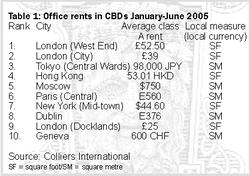| Dublin is 8th most expensive for office rents globally |
Back |
| London tops the most expensive list, but Dublin is still in the top ten globally, with average class A net rent €376 per m2. |
Dublin’s office rentals in its central business district (CBD) are the eighth highest globally. The average class A net rent in Dublin is €376 per square metre, while the top class A net rent achieved in Dublin during January to June 2005 was €538 per square metre, according to a new survey by Colliers International. Existing office floor space (classes A, B and C) within Dublin’s CBD was recorded as 1,382,820 square metres, with some 60,000 square metres of office space under construction.
The vacancy rate in Dublin is 6.2 per cent of total completed office space, which compares favourably with the 7.4 per cent vacancy rate which was recorded for the six months to December 2004. Michael Donohoe, a director with Colliers Jackson-Stops says that Dublin remains competitive in the face of the rising demand for office space worldwide which was witnessed during the period, and still provides an attractive working environment.
 | | Table 1: Office rents in CBDs January-June 2005 |
London is the most expensive city in the world for office rents, and features three times on the Top 10 list for three separate busines locations.
Offices in the West End are most expensive at ?52.50 per square foot, followed by the City with rents of ?39 per square foot. The Docklands area comes in ninth place, after Dublin, with rents of ?25 per square foot.
Overall, Asia Pacific was again a growth leader led by China, however, Latin America and North America also posted robust growth. The prognosis for the global office market is for vacancy rates to fall and rents to rise in the remainder of 2005 and into 2006. European markets began to show signs of more sustained growth in the period. Vacancy levels, which had been largely stagnant, moved lower during the first half of the year dropping by 80 basis points. Even German cities, which had been particularly sluggish, showed signs of stabilising with a number of markets posting lower vacancy levels. |
|
| Article appeared in the October 2005 issue.
|
|